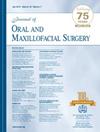传统唇裂修复与早期唇裂修复唇部修复率的比较:一项制度综述。
IF 2.3
3区 医学
Q2 DENTISTRY, ORAL SURGERY & MEDICINE
引用次数: 0
摘要
背景:传统的唇裂修复(TLR)是在3 - 6个月大的时候进行的。十多年来,我们的机构已经从提供唇裂修复前的手术鼻牙槽成型(NAM)过渡到在2至5周内进行早期唇裂修复(ECLR),避免了NAM的使用。目的:本研究旨在评估和比较接受ECLR和TLR±NAM的患者的唇部翻修率。研究设计、环境、样本:采用回顾性队列研究。2004年至2021年间在洛杉矶儿童医院接受初级修复的非综合征性单侧唇裂患者被纳入研究范围。排除标准如下:美国麻醉医师学会III级及以上分类,综合征或双侧病例,唇修复时矫正胎龄大于6个月,随访时间小于2年。预测变量:预测变量为初次唇裂修复的时间。受试者被分配到2个治疗队列中的1个:ECLR(主要结果变量:主要结果是在患者唇裂护理期间的任何时间进行唇部翻修手术。次要结果包括翻修手术的范围和时间。协变量:数据收集包括手术前NAM使用、外科医生、裂隙表型和裂隙宽度比。分析:根据外科医生、裂缝表型和裂缝宽度比,以1:1的比例进行了2阶段的粗精确匹配过程。Kaplan-Meier分析用于估计和比较修正率。结果:在研究期间,共有1101例患者接受了初级修复。应用排除标准后,362例患者未匹配。配对后纳入154例(ECLR 77例,TLR±NAM 77例)。Kaplan-Meier分析估计,与TLR±NAM组相比,ECLR组的5年翻修率较低(17.3% vs 32.6%,对数秩P)。结论和相关性:与TLR±NAM组相比,ECLR组的唇部翻修率降低了约2倍。这些研究结果表明,在大约1个月大的时候进行唇裂修复可以减少以后生活中二次手术的负担。本文章由计算机程序翻译,如有差异,请以英文原文为准。
Comparison of Lip Revision Rates in Traditional Versus Early Cleft Lip Repair: An Institutional Review
Background
Traditional cleft lip repair (TLR) is performed between 3 and 6 months of age. For over 10 years, our institution has transitioned from offering presurgical nasoalveolar molding (NAM) before cleft lip repair to performing early cleft lip repair (ECLR) within 2 to 5 weeks of life, circumventing the use of NAM.
Purpose
This study aimed to estimate and compare the lip revision rates between patients who underwent ECLR versus TLR ± NAM.
Study design, setting, sample
A retrospective cohort study was conducted. Patients with nonsyndromic unilateral cleft lip who underwent primary repair between 2004 and 2021 at Children’s Hospital Los Angeles were included. Exclusion criteria were as follows: American Society of Anesthesiologists classification III or higher, syndromic or bilateral cases, gestational-corrected age of more than 6 months at lip repair, and less than 2 years of follow-up.
Predictor variable
The predictor variable was the timing of primary cleft lip repair. Subjects were allocated to 1 of 2 treatment cohorts: ECLR (<3 months) and TLR ± NAM (3 to 6 months).
Main outcome variable
The primary outcome was lip revision surgery at any time during the patient’s cleft care. Secondary outcomes included the extent and timing of the revision surgeries.
Covariates
Data collection included presurgical NAM use, surgeon, cleft phenotype, and cleft width ratio.
Analyses
A 2-phased coarsened exact matching process was performed to match cohorts based on surgeon, cleft phenotype, and cleft width ratio at a 1:1 ratio. Kaplan-Meier analyses were used to estimate and compare the revision rates.
Results
A total of 1,101 patients underwent primary repair during the study period. After applying the exclusion criteria, 362 patients remained before matching. Among these, 154 patients (77 ECLR, 77 TLR ± NAM) were included after matching. Kaplan-Meier analysis estimated a lower 5-year revision rate for the ECLR cohort compared to the TLR ± NAM cohort (17.3 vs 32.6%, log-rank P < .05). Median follow-up time was 6.6 years [interquartile range 4.4 to 9.2].
Conclusions and relevance
ECLR resulted in approximately a 2-fold reduction in lip revision rates compared with TLR ± NAM. These findings suggest that cleft lip repair at approximately 1 month of age may decrease the burden of secondary procedures later in life.
求助全文
通过发布文献求助,成功后即可免费获取论文全文。
去求助
来源期刊

Journal of Oral and Maxillofacial Surgery
医学-牙科与口腔外科
CiteScore
4.00
自引率
5.30%
发文量
0
审稿时长
41 days
期刊介绍:
This monthly journal offers comprehensive coverage of new techniques, important developments and innovative ideas in oral and maxillofacial surgery. Practice-applicable articles help develop the methods used to handle dentoalveolar surgery, facial injuries and deformities, TMJ disorders, oral cancer, jaw reconstruction, anesthesia and analgesia. The journal also includes specifics on new instruments and diagnostic equipment and modern therapeutic drugs and devices. Journal of Oral and Maxillofacial Surgery is recommended for first or priority subscription by the Dental Section of the Medical Library Association.
 求助内容:
求助内容: 应助结果提醒方式:
应助结果提醒方式:


